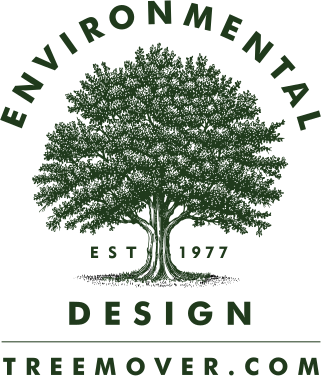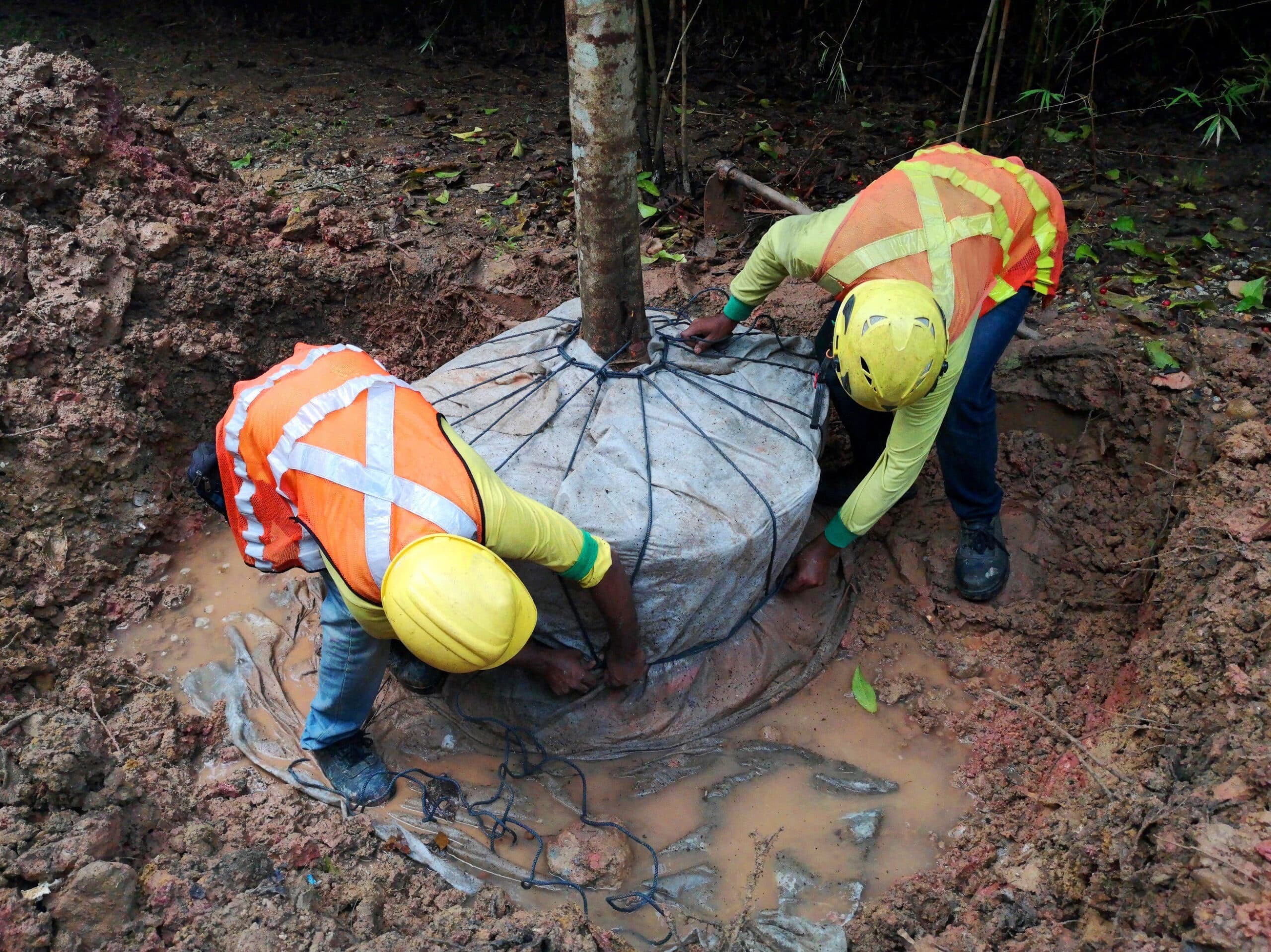A tree may survive the move — but will it thrive where it lands?
You can use the right equipment. You can prep the soil. You can plan the perfect path and execute a seamless move. But if the new site doesn’t match the tree’s natural climate, none of it will matter.
The truth is: climate zone compatibility isn’t just a technicality in tree transplanting — it’s the key to long-term survival. Ignore it, and you risk wasting time, money, and years of growth. Understand it, and you can unlock the full potential of your landscape.
Whether you’re relocating a legacy oak across town or sourcing a specimen from another state, climate zones shape the outcome. At Environmental Design, Inc., we build every move around this principle.
What exactly is a climate zone — and why does it matter?
Climate zones are geographic areas defined by temperature ranges, frost dates, humidity, and precipitation patterns. The USDA Hardiness Zone Map, the most widely used tool in the U.S., assigns each region a zone number based on the average annual minimum winter temperature.
But this isn’t just a garden planner’s tool — it’s essential for transplant success. A tree adapted to Zone 10 (warm winters) likely won’t survive a move to Zone 6 (cold winters), even if the soil and sunlight are ideal. The opposite is true, too: cold-adapted trees can suffer in hotter zones with longer droughts.
Transplanting outside of a tree’s native or adapted zone places it under chronic stress — making it more susceptible to pests, disease, and decline.
3 key climate zone factors that affect tree transplanting
1. Temperature Tolerance
Some trees can tolerate a wide range of temperatures. Others are far more sensitive. A Southern live oak thrives in Zone 9, but risks freeze damage in Zone 7. Conversely, sugar maples struggle in hotter, arid zones.
Always match the tree’s cold hardiness or heat tolerance with the zone it’s going into. Even short-term exposure to unsuitable temperatures can undo years of growth.
2. Rainfall & Humidity
Water needs don’t just vary by species — they’re influenced by regional humidity and precipitation. A tree used to humid Gulf Coast conditions may suffer in a dry desert transplant, even if irrigation is added.
Microclimates matter, too. An east-facing slope may retain moisture, while a hilltop dries out fast. Climate-aware planning means evaluating both the broad zone and the unique site conditions.
3. Dormancy Cycles & Seasonal Timing
Moving a tree while it’s actively growing is risky, especially in extreme climates. Transplanting during dormancy — typically late fall through early spring — reduces shock and improves survival odds. But the ideal window varies by zone.
In warm climates, some trees never go fully dormant. In colder ones, digging before the ground freezes is essential. Understanding local cycles helps us schedule the safest, most strategic moves.
Selecting species for long-term success
Choosing a tree that naturally aligns with your climate zone gives it a biological head start. Native and adapted species are already acclimated to your region’s temperature swings, soil type, wind exposure, and rainfall. This means fewer interventions, less stress, and higher transplant success.
At Environmental Design, Inc., we guide clients through species selection based on zone, site conditions, and long-term vision. Our custom sourcing ensures that transplanted trees not only survive — they become legacy pieces of the landscape.
Microclimates: the hidden factor in every yard
Even within a single property, conditions can vary drastically. A tree on the north side of your home may be exposed to shade and wind, while one on the south side enjoys full sun and shelter. These microclimates are critical to understand when relocating a tree.
We assess slope, airflow, sunlight angles, and heat-retaining surfaces (like driveways or walls) to determine the best new location for each tree. It’s not just about your zone — it’s about where in your zone that tree will thrive.
Elevation and exposure: the vertical climate zones
Elevation has a surprising impact on climate, especially in mountainous or hilly regions. Higher elevations are cooler and often wetter, while lower areas may be hotter and prone to frost pockets. A tree moved just 200 feet uphill or downhill may experience significantly different growing conditions.
Before any transplant, we analyze elevation changes between origin and destination to avoid placing a tree into a thermal or moisture mismatch — a detail that often goes overlooked in standard landscaping practices.
Tree maturity and zone adaptability
Younger trees are more adaptable to new environments. Mature specimens, however, have deep-rooted responses to their original climate. Transplanting a 30-year-old tree into a new zone isn’t impossible — but it requires precision.
At Environmental Design, Inc., we consider maturity when evaluating climate fit. We may recommend soil amendments, transitional nursery care, or staged planting strategies to help older trees acclimate safely to their new setting.
Climate-aware aftercare: the secret to long-term success
The work doesn’t end after the tree is in the ground. Trees transplanted into different climate zones often need specialized care in the first year: irrigation adjustments, mulching, wind shielding, and gradual exposure to sun or shade.
Our aftercare programs are built zone-by-zone, incorporating seasonal temperature shifts, pest cycles, and moisture levels. This climate-specific care ensures your investment not only survives the move — it thrives long after.
How climate change is reshaping transplanting strategies
Climate zones are no longer static. Due to global warming, what was once Zone 7B may now be trending toward 8A. These subtle shifts affect not only what trees thrive where — but also how long they survive.
That’s why Environmental Design, Inc. considers future zone drift in all transplant planning. Our team consults NOAA data and regional climate models to make sure we’re planting for both the present and the future.
Urban heat islands: the invisible transplant challenge
In cities, the climate zone can vary block by block. Asphalt, concrete, and glass retain heat, pushing temps 10–15°F higher than surrounding rural areas. This “urban heat island effect” means trees in city cores experience hotter, drier microclimates — even within a cooler zone.
When relocating a tree into an urban setting, Environmental Design, Inc. adjusts species selection, planting depth, irrigation strategy, and root zone aeration accordingly.
Understanding chill hours in fruit and ornamental trees
Chill hours — the amount of time a tree needs cold temperatures to trigger growth cycles — are critical for certain species. Apples, cherries, dogwoods, and tulip poplars all rely on seasonal chill for bud break.
If a tree is relocated to a warmer climate with insufficient chill hours, it may never flower or set fruit again. Our team works closely with horticulturists to map chill hour averages and recommend tree varieties that match both zone and seasonal cycles.
Transplanting across moisture gradients
A climate zone defines temperature tolerance, but moisture gradients define water availability. A tree that’s moved from a wet climate to an arid one may suffer not just from drought stress but from incompatible root morphology.
Shallow-rooted species can desiccate quickly in dry, windy zones. In these cases, we often recommend root pruning, temporary shading, anti-desiccant treatments, and zone-specific watering systems during establishment.
Designing transplant timelines around climate volatility
Extreme weather is now more common — including unseasonal freezes, heat waves, and flash droughts. Planning a transplant means avoiding these windows as much as possible.
At Environmental Design, Inc., our climate risk mitigation model uses historical weather patterns and predictive tools to identify optimal transplant windows down to the week. We don’t just consider season — we track wind events, soil temps, and regional drought cycles to improve transplant outcomes.
The role of root zone temperature in post-transplant success
Above-ground climate is only half the picture. Soil temperatures play a major role in root regeneration. Cold, compacted, or poorly draining soils can stunt a tree’s ability to reestablish.
We use temperature probes and zone-specific insulation methods (like compost blankets and mulch domes) to moderate soil temperatures during and after transplant — ensuring roots can remain active even when air temps fluctuate wildly.
Partnering with land stewards and municipalities for zone resilience
From civic boulevards to museum grounds, Environmental Design, Inc. works with long-term land stewards to make tree transplanting part of a climate resilience plan. Whether it’s preserving shade corridors, preventing erosion, or maintaining habitat in warming zones, our work contributes to both urban canopy goals and ecological integrity.
Why zone-smart transplanting protects your investment
A tree that fails post-transplant doesn’t just represent lost labor — it’s a sunk cost in sourcing, transport, and time. By integrating zone data into every decision, we ensure every tree we relocate has the best chance to not only survive — but grow into its full, long-term value.
Whether you’re investing in legacy oaks, heritage orchards, or municipal street trees, zone-smart planning protects that investment for decades to come.
The right climate. The right time. The right team.
Successful tree transplantation doesn’t end with the move — it starts with the environment. By understanding your climate zone and working with a team that prioritizes zone compatibility, you set your tree up for decades of growth, shade, and beauty.
At Environmental Design, Inc., we’ve spent over 40 years helping trees thrive in their new homes. Our process doesn’t just move trees — it moves them wisely.
Visit www.treemover.com to connect with our experts and plan a climate-smart transplant today.






Join the discussion 2 Comments